Fast Facts
- When: 13th April 2024
- Where: Aintree, Liverpool
- Watch: ITV Racing
- Official Website: Randox Health Grand National
The Grand National is a steeplechase held every year in April at Aintree racecourse on Merseyside. The race is one of sport’s great spectacles, with a field of up to 34 runners and riders taking on those famous fences over the marathon distance of 4 miles 2½ furlongs.
The Grand National is probably the most iconic horse jumps race in the world, watched by tens of thousands in attendance and by millions around the world who tune in to watch on tv. It normally comes with a monumental prize fund of £1 million, with winning horses, jockeys and trainers cementing their place in the history books.
The race is the climax to the three day Aintree Grand National Festival, which starts on a Thursday, with the big race itself taking place on the Saturday. Below we will highlight the best promotions and extra place offers available when it comes to placing your bets.
Number Of Places On The Grand National
One huge thing to look at when choosing who to place your bets with is the number of places they pay out to, as it can literally mean the difference between your bet winning or losing. Put simply the number of places is the position the horse can come in and win the 'Place' portion of an each way bet.
So if you horse comes in 6th and your bookie pays to 5 places, you will have lost your bet. But if they pay to 6 places, then you win. Bit of a no brainer to pick someone with the most places, right? You might decide to have 5 places instead of 6 in return for 1/4 odds rather than 1/5 odds however.
Existing Customer Free Bets & Money Back Offers
Please Note: This event has now ended.
Stats Articles
- How Many Mares Have Won the Grand National?
- How Often Does a Grey Horse Win the Grand National?
- What is the Average Number of Finishers in the Grand National?
- Do More Horses Fall in the First or Second Circuit of the Grand National?
- How Often Does an Amateur Jockey Win the Grand National?
- What Percentage of Horses Fall in the Grand National?
- What is the Average Age of the Grand National Winner?
- Which Horses Have Won The Grand National More Than Once?
- Female Jockeys In The Grand National: Has A Woman Ever Won the Race?
- How Often Does The Favourite Win The Grand National?
- Longest & Shortest Odds Winners In The Grand National
Event Stats
Grand National 2024 Full Result
| Position | Horse | Jockey | Trainer | Weight | SP |
|---|---|---|---|---|---|
| 1 | I Am Maximus | Paul Townend | Willie Mullins | 11-6 | 7/1 |
| 2 | Delta Work | Jack Kennedy | Gordon Elliott | 11-4 | 28/1 |
| 3 | Minella Indo | Rachael Blackmore | Henry de Bromhead | 11-6 | 28/1 |
| 4 | Galvin | Sam Ewing | Gordon Elliott | 11-2 | 40/1 |
| 5 | Kitty’s Light | Jack Tudor | Christian Williams | 10-7 | 12/1 |
| 6 | Ain’t That A Shame | David Maxwell | Henry de Bromhead | 10-13 | 40/1 |
| 7 | Meetingofthewaters | Danny Mullins | Willie Mullins | 10-8 | 11/1 |
| 8 | Galia Des Liteaux | Harry Skelton | Dan Skelton | 10-7 | 28/1 |
| 9 | Roi Mage | James Reveley | Patrick Griffin | 10-8 | 66/1 |
| 10 | Limerick Lace | Mark Walsh | Gavin Cromwell | 10-8 | 7/1 |
| 11 | Coko Beach | Jordan Gainford | Gordon Elliott | 11-8 | 28/1 |
| 12 | Latenightpass | Gina Andrews | Tom Ellis | 10-10 | 50/1 |
| 13 | The Goffer | Sean Bowen | Gordon Elliott | 10-8 | 50/1 |
| 14 | Vanillier | Sean Flanagan | Gavin Cromwell | 10-12 | 14/1 |
| 15 | Eklat De Rire | Darragh O’Keeffe | Henry de Bromhead | 10-7 | 100/1 |
| 16 | Capodanno | Keith Donoghue | Willie Mullins | 11-8 | 28/1 |
| 17 | Panda Boy | J J Slevin | Martin Brassil | 10-7 | 11/1 |
| 18 | Nassalam | Caoilin Quinn | Garry Moore | 11-8 | 50/1 |
| 19 | Noble Yeats | Harry Cobden | Emmet Mullins | 11-12 | 12/1 |
| 20 | Eldorado Allen | Brendan Powell | Joe Tizzard | 11-0 | 66/1 |
| 21 | Adamantly Chosen | Sean O’Keeffe | Willie Mullins | 10-9 | 33/1 |
Grand National 2024 Runners & Riders
| No. | Horse | Weight | Age | Trainer | Jockey | Odds |
|---|---|---|---|---|---|---|
| 1 | Noble Yeats | 11-12 | 9 | Emmet Mullins | Harry Cobden | 20/1 |
| 2 | Nassalam | 11-8 | 7 | Garry Moore | Caoilin Quinn | 20/1 |
| 3 | Coko Beach | 11-8 | 9 | Gordon Elliott | Jordan Gainford | 20/1 |
| 4 | Capodanno | 11-8 | 8 | Willie Mullins | Keith Donoghue | 25/1 |
| 5 | I Am Maximus | 11-6 | 8 | Willie Mullins | Paul Townend | 7/1 |
| 6 | Minella Indo | 11-6 | 11 | Henry de Bromhead | Rachael Blackmore | 20/1 |
| 7 | Corach Rambler | 11-6 | 10 | Lucinda Russell | Derek Fox | 6/1 |
| 8 | Janidil | 11-6 | 10 | Willie Mullins | Jody McGarvey | 100/1 |
| 9 | Stattler | 11-5 | 9 | Willie Mullins | Patrick Mullins | 40/1 |
| 10 | Mahler Mission | 11-5 | 8 | John C McConnell | Ben Harvey | 16/1 |
| 11 | Delta Work | 11-4 | 11 | Gordon Elliott | Jack Kennedy | 25/1 |
| 12 | Foxy Jacks | 11-4 | 10 | Mouse Morris | Gavin Brouder | 66/1 |
| 13 | Galvin | 11-2 | 10 | Gordon Elliott | Sam Ewing | 33/1 |
| 14 | Farouk D’alene | 11-1 | 9 | Gordon Elliott | Donagh Meyler | 80/1 |
| 15 | Eldorado Allen | 11-0 | 10 | Joe Tizzard | Brendan Powell | 100/1 |
| 16 | Ain’t That A Shame | 10-13 | 10 | Henry de Bromhead | David Maxwell | 66/1 |
| 17 | Vanillier | 10-12 | 9 | Gavin Cromwell | Sean Flanagan | 8/1 |
| 18 | Mr Incredible | 10-11 | 8 | Willie Mullins | Brian Hayes | 12/1 |
| 19 | Run Wild Fred | 10-10 | 10 | Gordon Elliott | Tom Hamilton | 100/1 |
| 20 | Latenightpass | 10-10 | 11 | Tom Ellis | Miss Gina Andrews | 25/1 |
| 21 | Minella Crooner | 10-10 | 8 | Gordon Elliott | Kevin Sexton | 80/1 |
| 22 | Adamantly Chosen | 10-9 | 7 | Willie Mullins | Sean O’Keeffe | 50/1 |
| 23 | Mac Tottie | 10-9 | 11 | Peter Bowen | James Bowen | 100/1 |
| 24 | Chemical Energy | 10-9 | 8 | Gordon Elliott | Danny Gilligan | 33/1 |
| 25 | Limerick Lace | 10-8 | 7 | Gavin Cromwell | Mark Walsh | 16/1 |
| 26 | Meetingofthewaters | 10-8 | 7 | Willie Mullins | Danny Mullins | 8/1 |
| 27 | The Goffer | 10-8 | 7 | Gordon Elliott | Sean Bowen | 66/1 |
| 28 | Roi Mage | 10-8 | 12 | Patrick Griffin | James Reveley | 50/1 |
| 29 | Glengouly | 10-7 | 8 | Willie Mullins | Michael O’Sullivan | 66/1 |
| 30 | Galia Des Liteaux | 10-7 | 8 | Dan Skelton | Harry Skelton | 25/1 |
| 31 | Panda Boy | 10-7 | 8 | Martin Brassil | J J Slevin | 14/1 |
| 32 | Eklat De Rire | 10-7 | 10 | Henry de Bromhead | Darragh O’Keeffe | 100/1 |
| 33 | Chambard | 10-7 | 12 | Venetia Williams | Lucy Turner | 66/1 |
| 34 | Kitty’s Light | 10-7 | 8 | Christian Williams | Jack Tudor | 16/1 |
About The Grand National
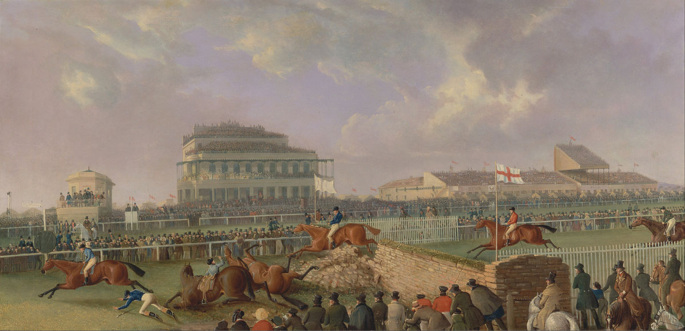
The Grand National takes place at Aintree Racecourse in Liverpool. The race was first run in 1836, making it one of the oldest races still in existence. The stand out feature of the Grand National is the sheer length of the race, measuring a massive four miles two and a half furlongs, often taking around ten minutes for the horses to complete.
The Grand National is always held in April and usually takes place on the first or second weekend of the month. Due to the race being held on free-to-air television its the most watched horse race in the world, with a reported 600 million people tuning in every year, from over 140 countries.
The Origins of The Grand National
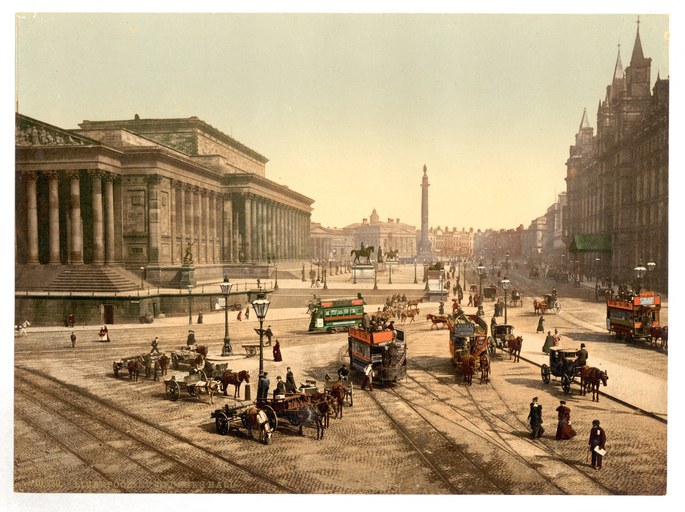
Lime Street in Liverpool at the end of the 19th Century by Ashley Van Haeften, flickr
The race was the brainchild of a man called William Lynn, who wanted to host a horse race, so leased some land from the Second Earl of Sefton to do it. That was back in 1829, when Lynn laid out the racecourse, built a grandstand and asked the Earl of Sefton to place the foundation stone. If you’ve read anything about the history of the Grand National before now then you’ll know that the first official race took place in 1836, which is because there’s no definitive proof that the races before that year actually took place at Aintree.
Though the race’s inaugural running was in 1836, it wasn’t until the end of the decade that Aintree started to be taken more seriously by the wider racing community. The fact that the Great St. Albans Chase stopped in 1838 might have something to do with that. Also the fact that train travel was becoming more popular, and Liverpool Lime Street Station was one of the largest train stations in the world, might have encouraged more spectators to travel to watch the race. Whatever the reason, its popularity grew, which might go a long way to explain why 1839 is considered to be the official first running of the race.
Becoming a Handicap Chase
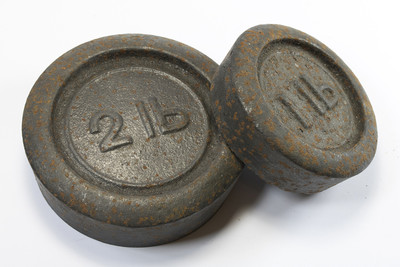 When the National was first run it was a weight-for-age race, which was what William Lynn wanted it to be. As his health started to fail, however, he began to hand over the organisation of the race to Edward Topham, who was a well respected handicapper. Fitting with his own expertise, Topham decided to change the National to make a handicap race, which in turn meant that it became a far more open contest. That happened for the first time in 1843 and it was run as a handicap race from then on. With each passing year the Grand National garnered more and more attention, becoming one of the most popular races in the British racing calendar.
When the National was first run it was a weight-for-age race, which was what William Lynn wanted it to be. As his health started to fail, however, he began to hand over the organisation of the race to Edward Topham, who was a well respected handicapper. Fitting with his own expertise, Topham decided to change the National to make a handicap race, which in turn meant that it became a far more open contest. That happened for the first time in 1843 and it was run as a handicap race from then on. With each passing year the Grand National garnered more and more attention, becoming one of the most popular races in the British racing calendar.
A Predictably Unpredictable Race
 Part of the reason for the race’s burgeoning popularity was the fact that punters felt as if any of the participating horses could win it. That idea would later be solidified in 1967 when a horse named Popham Down, that had unseated its rider earlier in the race, veered in front of the twenty-third fence. As it veered it crashed into Rutherford and a pileup ensued, causing virtually every horse to either fall or refuse to jump the fence. Every horse, that is, apart from Foinavon who was so far behind the main horses that it was able to steer around them, jump the fence and win the race as a 100/1 outsider.
Part of the reason for the race’s burgeoning popularity was the fact that punters felt as if any of the participating horses could win it. That idea would later be solidified in 1967 when a horse named Popham Down, that had unseated its rider earlier in the race, veered in front of the twenty-third fence. As it veered it crashed into Rutherford and a pileup ensued, causing virtually every horse to either fall or refuse to jump the fence. Every horse, that is, apart from Foinavon who was so far behind the main horses that it was able to steer around them, jump the fence and win the race as a 100/1 outsider.
That pileup came about forty years after another famous race that saw a different 100/1 winner. In 1967 it was all about the pileup, whilst in 1928 Tipperary Tim won because forty-one of the other horses fell during the race, leaving the long-shot to finish almost uncontested.
Another interesting story took place in 1956 when Devon Loch, owned by the Queen and Queen Mother, was running towards the finish line after making it over the final fence but collapsed before ending the race. The most famous horse of all time however when it comes to the National is undoubtedly Red Rum.
Red Rum, a National Hero
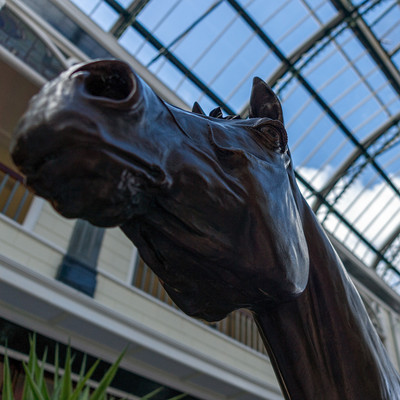
By Beverley Goodwin, flickr
Red Rum was bought for the equivalent of about £420 in today’s money back in 1966. Ginger McCain, the trainer, then purchased him for the equivalent of about £6,300 and soon realised the potential that he had. McCain had heard stories of lame carthorses being run in the sea, so when he noticed that Red Rum was showing signs of being lame he took him into the sea at Southport Beach. Whether the horse would’ve become lame or not will never be known, but it’s entirely fair to say that he recovered from whatever problems he was having.
Red Rum’s love affair with the National began in 1973. In the race he found himself fifteen lengths behind a horse by the name of Crisp by the last fence. Despite the huge lead, Red Rum caught him up and won the race by three-quarters of a length. He defended his title the following year, finished second in both 1975 and 1976 before winning again in 1977. No other horse has ever managed to win the race more than twice, meaning that Red Rum remains a record-setting horse. References to this great champion can be found all around Aintree Racecourse.
Seagram Just the Tonic in the 1980’s
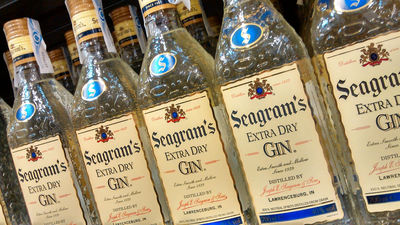 Despite many romantic races over the years, such as the time Bob Champion winning the race in 1981 despite having been diagnosed with testicular cancer two years earlier and given only months to live, the Grand National was becoming less and less prestigious as the 1980s wore on. A likely cause would have been the state of the city of Liverpool itself at the time, with strikes, riots and a decision by Margaret Thatcher and her government to leave the city in a state of ‘managed decline’.
Despite many romantic races over the years, such as the time Bob Champion winning the race in 1981 despite having been diagnosed with testicular cancer two years earlier and given only months to live, the Grand National was becoming less and less prestigious as the 1980s wore on. A likely cause would have been the state of the city of Liverpool itself at the time, with strikes, riots and a decision by Margaret Thatcher and her government to leave the city in a state of ‘managed decline’.
Regardless of the reasons, the Grand National had lost its lustre. As a result, a decision was taken to bring on a sponsor, with the Canadian company Seagram taking on the duty. It was at this time that the race also moved under the umbrella of the Jockey Club, who put money into the race in order to revive its fortunes and ensure that people would still take it seriously. The combination of the sponsorship and the Jockey Club worked, with the race regaining its popularity heading into the 1990s.
Rerun and Abandoned Races in the 1990’s
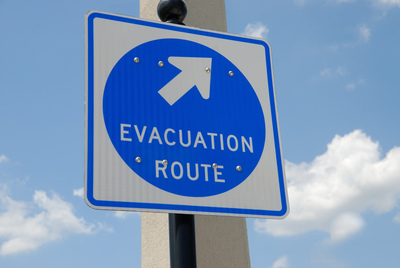 In 1992 the race became known as the Martell Grand National, with the brandy maker taking over from Seagram as the chief sponsor. It was to be a decade of controversy for the National. In 1993, for example, a jockey was entangled in the starting tape and a false start had to be declared. This wasn’t communicated well to the rest of the field however, and 30 of the 39 horses in the race ended up completing the circuit. Seven of them ran the entire way around, with Esha Ness crossing the line first. Unfortunately the fact that a restart had been called meant that the race was declared void, meaning that Esha Ness is known as the horse that won ‘The Race That Never Was’.
In 1992 the race became known as the Martell Grand National, with the brandy maker taking over from Seagram as the chief sponsor. It was to be a decade of controversy for the National. In 1993, for example, a jockey was entangled in the starting tape and a false start had to be declared. This wasn’t communicated well to the rest of the field however, and 30 of the 39 horses in the race ended up completing the circuit. Seven of them ran the entire way around, with Esha Ness crossing the line first. Unfortunately the fact that a restart had been called meant that the race was declared void, meaning that Esha Ness is known as the horse that won ‘The Race That Never Was’.
That was an unfortunate occurrence but wasn’t as serious as what happened in 1997. With horses, jockeys, owners and racegoers all arriving in Aintree, it was declared that the race would be abandoned after the Irish Republican Army had called in one coded bomb threat followed by another. The people of Liverpool threw open their doors to those that couldn’t leave the city as coaches and cars were locked inside the racecourse. The National was run on the following Monday instead, with twenty-thousand people given free entry to the course.
Animal Welfare Concerns Addressed
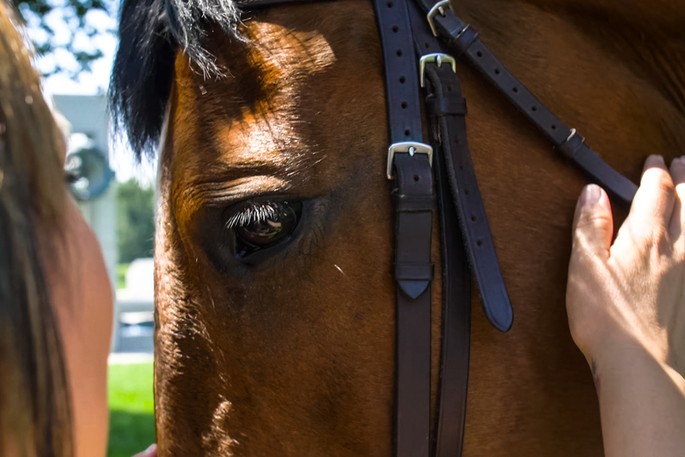
The race is a steeplechase and one of its crowning glories is the challenge it poses to the horses to get over some of the monumental fences that are on offer. In fact, a lot of the horses fail to finish the race, either due to exhaustion or falling when jumping. However, in more recent years this has brought the race under scrutiny from animal welfare groups, claiming that the test is too much for most. Supporters argue that the aim of the Grand National is to be the ultimate test for both horses and jockeys alike.
Even so, it has always been the aim of the organisers of the Grand National to make it a challenge without putting the lives of the animals at risk. The British Horseracing Authority suggest that four horse die in steeplechases for every one thousand that take part in them. In the decade between 2000 and 2010, though, the figure was higher for the Grand National as 6 of 439 horses died during that period. As a result, those at Aintree have worked closely with animal welfare parties to make the race as safe as it can be.
Changes brought in include the modification of fences such as Becher’s Brook to see the drop made shorter and the incline less severe. Changes have meant that no horses died in the Grand National between 2012 and 2018 however, Up For Review in 2019, The Long Mile in 2021, Eclair Surf and Discorama in 2022 and Hill Sixteen in 2023 were all sadly fatally injured during the race. Those that weren’t keen on the race being altered pointed to the twelve horses that died between 1970 and 1989, a time when the welfare of the animals taking part in the event was barely considered. Regardless, the changes have helped to appease the more vociferous concerns.
Ahead of the 2024 race, additional measures have again been introduced to improve horse welfare. The maximum field has been reduced to 34, and the minimum rating has been upped to 130. The race has also been moved forward to 4pm, from 5:15pm, to reduce the waiting time for runners and also to make sure they are running on better ground.
The Famous Fences
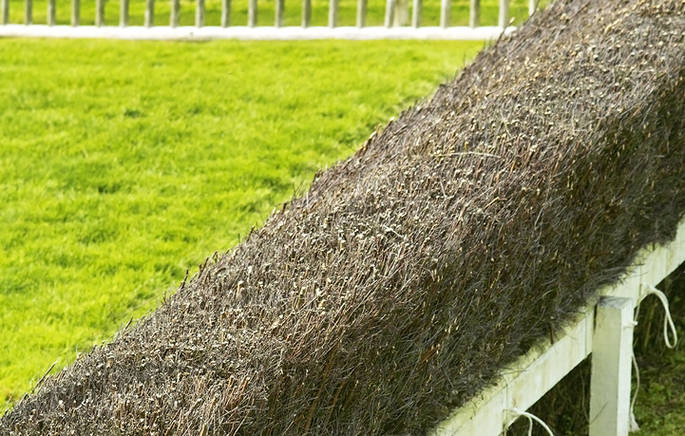
The National asks horses to jump thirty fences over two laps. Sixteen of these fences are found on the first circuit, with fourteen of those to be jumped again on the second. If you’re wondering, the Water Jump and The Chair are the two that are only jumped the first time around. Here’s a look at some of the other well-known fences.
The first fence is one that often catches a lot of the horse out, due it being a significant distance from the start, meaning they are travelling at quite a pace by the time they reach it. The 1.37 metre fence is notorious for fallers, with many bookmakers actually offering odds for certain numbers and even specific horses to fall at this point.
Becher’s Brook is the first of the high-profile fences and comes sixth on the course. It stands at a daunting 1.52 metres and includes a water splash at the landing side. It requires a great deal skill and timing to negotiate it properly. The name came from Captain Martin Becher, who fell there in first Grand National, to then take refuge in the Brook to avoid getting trampled on by passing horses. Valentine’s reportedly received its name when a horse named Valentine jumped over the ninth fence backwards in 1840.
The Chair is the biggest fence on the course, measuring a massive 1.57 metres. The ground leading up to the jump is actually six inches higher than the landing side, which is tough for the horse and jockey to anticipate and negotiate. The fence still remains the only one from the race to have taken a human life, which happened back in 1862 when Joseph Wynne fell from his horse, passing away later that day.
Interesting Facts
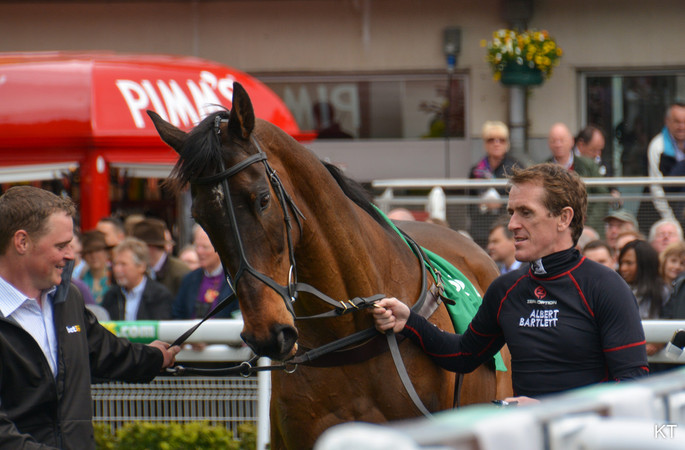
The horse that has won the Grand National the most time is the aforementioned Red Rum. His three victories in 1973, 1974 and 1977 have never been repeated and are the main reason why Red Rum went on to be one of the most iconic horses in racing history.
The trainer Ginger McCain is the joint most successful trainer of all time, winning the National no less than four times. As well as being the trainer of Red Rum for all of his wins, McCain managed to repeat the feat with Amberleigh House in 2004. Two other trainers, Fred Rimell and George Dockeray, have also won four Grand Nationals.
Throughout the race’s history, the longest price to ever win the race was 100/1, which has happened on five occasions. Mon Mome is the most recent horses to win the race at that price in 2009. AP McCoy has had the second most rides in the Grand National at 20, but it took him 15 attempts to get his only win in 2010 with Don’t Push It. Richard Johnson has the most rides at 21 though he never won the race. Here are some other interesting facts about the race and its history:
- Just 15% of favourites have gone on to win the race since it first took place
- 63% of horses that start the race fail to complete it, which is around 21 horses in a field of 34
- The Chair and the Water Jump have reputations as being tough fences, but only around 2.5% of all horses fall at them in total
- The First is the fence most likely to claim a horse and rider, with Becher’s Brook the second most likely
- In 1929, sixty-six horses took part in the race – the largest field ever
- Since 1990, the average age of the winning horse is 9.5
- Just three grey horses have won the race. The Lamb (1868), Nicolaus Silver (1961) and Neptune Collonges (2012)
- Neptune Collenges won the race by a nose over Sunnyhillboy in 2012, the closest ever finish in the Grand National
- The first female jockey to compete in the race was Charlotte Brew in 1977
- The first female winning jockey was Rachael Blackmore in 2021 on Minella Times
- The Grand National is the principle race at the end of a three day festival of racing
